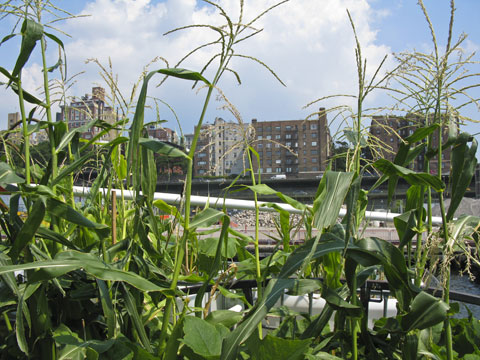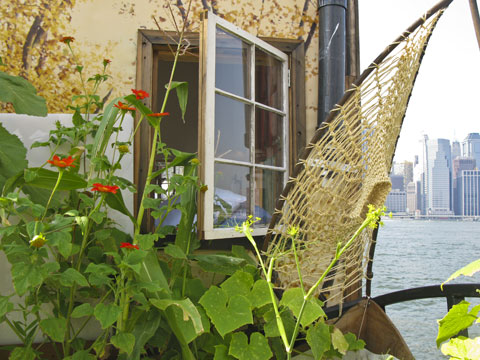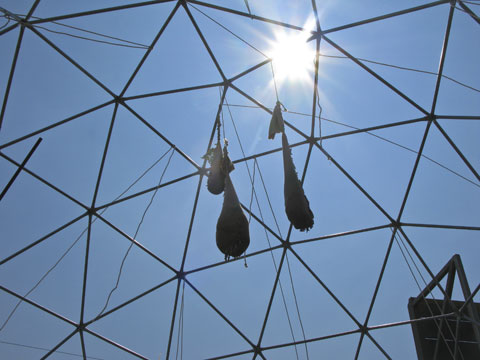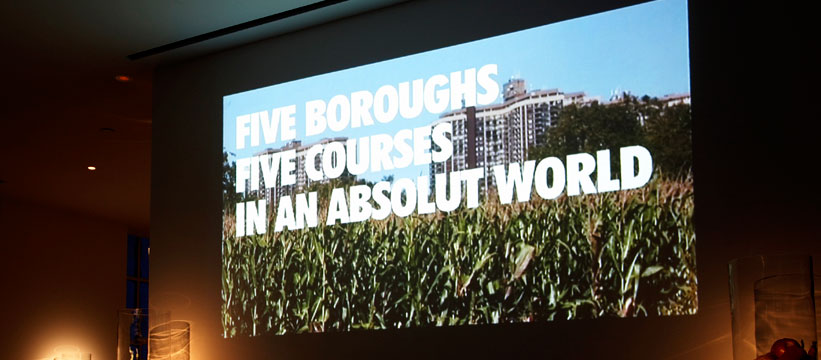With resources on land becoming scarcer by the day, and sea levels rising, the idea that we may one day have to adapt to life on the sea may not be so far fetched. The Waterpod™ is a project envisioned by artist Mary Mattingly as a kind of aquatic equivalent to Biosphere 2, a science complex built in the Arizona desert in the 1980s. She says, “I began to design these as I was traveling often and as I became increasingly worried that government and corporate agencies were largely ignoring problems caused by pollution and climate change. I wanted to respond to the growing instability of cultures and the political unrest arising from inattention to these issues.”
I visited The Waterpod on a particularly hot weekend when it was docked at Pier 5 at the end of Joralemon Street, a fine stretch of Brooklyn waterfront, where today you will normally not see a soul, but when the Brooklyn Greenway finally opens, will be on par with the High Line. It was bustling with activity, people of all ages partaking in lectures, activities and gardening. A volunteer showed us a solar cooking contraption she had just used boiled coffee, we saw the largest sunflowers we had ever seen (they must like it on the water), and broke a sweat on a stationary bike to help charge a drill battery. The crew’s living quarters, small as they were, offered up the most amazing views on downtown Manhattan. Seems like a pretty good place to live if you ask me.
The Waterpod is an entirely self-sustaining ecosystem; the on-board crew grow their own food, compost, capture, purify and recycle water, and generate electricity through a mix of solar, wind and kinetic bicycle power. Mattingly talks about the process, “It was interesting to learn how to create this kind of system, one that the inhabitants would not necessarily need to leave and that could exist as a mobile space. Finding sustainable solutions for living made me question the design, as well as the role of community in the space. I thought about the relationship between individuals and utopian spaces and kept in mind future possibilities. At first, I designed it as a personal space, but as the idea evolved, it became clear that it needed community to be sustainable and to benefit from multiple inputs and interpretations. I became more interested in the benefits that could be gained from a diverse community living on and interacting with the pod. I started to form a group of people who were interested in the project, either from an artistic, infrastructural, or technological point of view. Eventually, we formed a democratic group, a meritocracy, and developed a set of guidelines. Right now, there are five people who will be living on The Waterpod. Everyone will have to help out with repairs, gardening, cooking, and composting. Basically, everyone will learn how to take care of everything. I think this is really important — as the first industrial and technological age in the developed world is drawing to a close, people need to relearn how to do a lot of things.”
Other Waterpod inhabitants include Derek Hunter and Alison Ward, who built the modular superstructure in a warehouse in Long Island City, Vancouver-based artist Mira Hunter, one of the first to come on board and help in the imagining of the project, artist Stephanie Dedes, who coordinated a barter system with local greenmarkets, Carissa Carman,who designed the on-board living system. Engineering students also helped build some of the technological elements, and many more people have been involved in bringing the project to life. There were some mishaps and bureaucratic bouts along the way; there was the first barge that sank, the animal exhibition permit that had to be secured (since they had chickens on board and the public would be visiting), and a malfunctioning gangplank that delayed the opening. Due to various environmental guidelines, the pod needs to move every two weeks, which means a lot of different piers, more permits and insurance policies had to be secured. The project has been a tremendous success and has garnered lots of attention from the press and the public.
Even though the project was initially imagined to have a long life span, but mid-October may be the last chance to pay a visit. The Waterpod is soon leaving Staten Island, and will be docked at Concrete Plant Park in the Bronx from September 1-14, at the World’s Fair Marina in Queens from September 15-29, and in a location yet to be determined from September 29 – October 12. Before going, make sure to check the docking schedule for potential changes.
“With this project, we hope to encourage innovation as we visualize the future fifty to one hundred years from now.” -Mary Mattingly

































